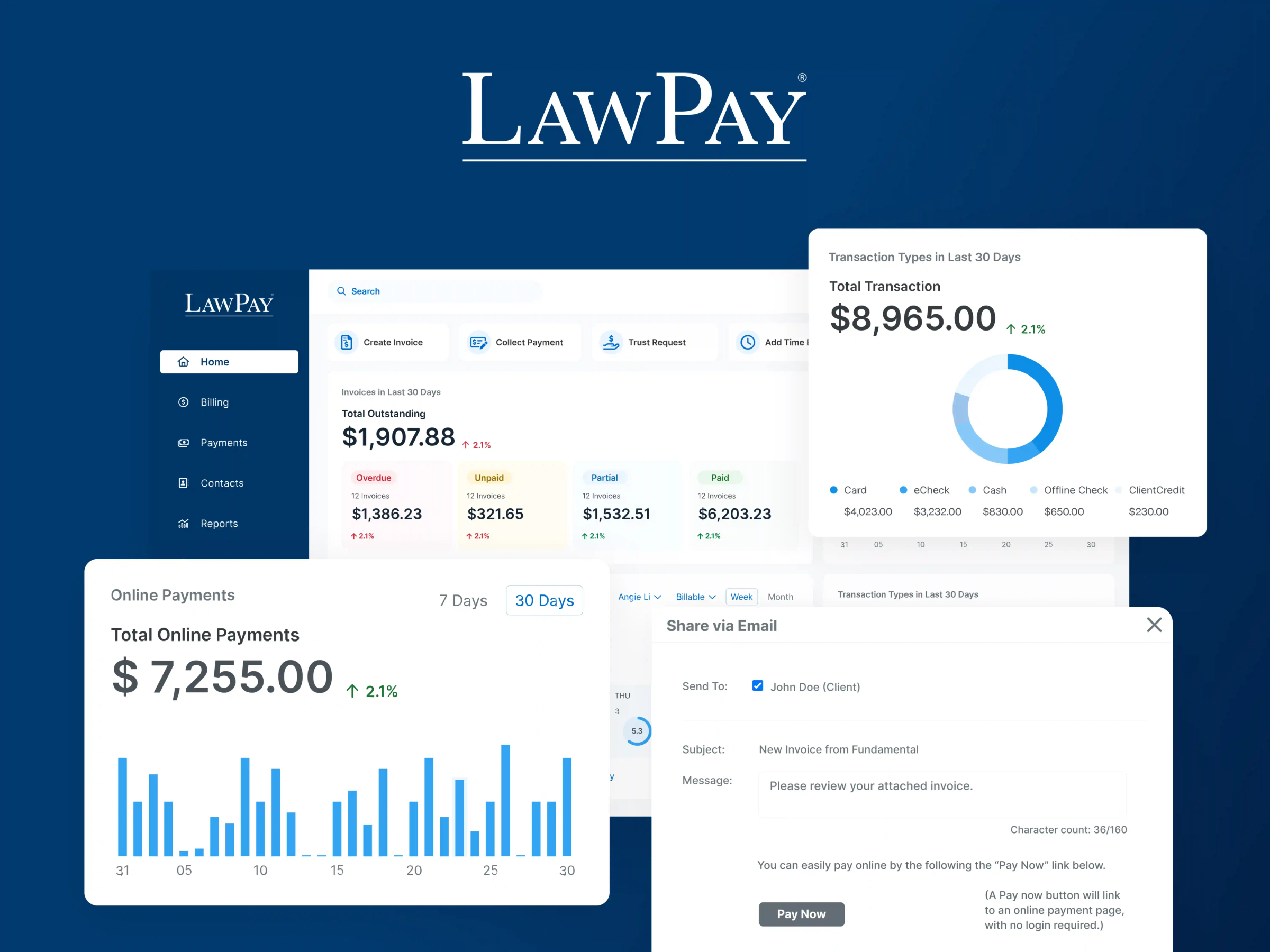Key takeaways
Trust accounting is specialized bookkeeping for client trust accounts. It ensures client funds are managed separately from the firm’s operating accounts in compliance with legal and ethical standards.
Client trust accounts safeguard client money so they are not commingled with attorney or firm assets.
The core purpose of trust accounting is compliance. Accurate tracking and three-way reconciliations prevent misuse of funds and help attorneys stay aligned with state bar rules.
Managing client trust accounts is vital to a lawyer’s role, but it can feel like walking a tightrope. Staying compliant while navigating a maze of rules and regulations is no easy feat.
This guide will provide an overview of trust accounting, talk about the challenges of remaining in compliance with trust account rules, and discuss various software tools that make trust accounting safer and easier.
What is Trust Accounting?
In its most essential form, trust accounting is defined as bookkeeping for trust accounts in accordance with legal and ethical requirements. However, there are nuances to consider. Let’s take a closer look.
What is a Client Trust Account?
A client trust account is like a safe haven for your client's funds, separate from your firm’s operating accounts. It’s where you hold money on behalf of your clients, ensuring it's used exclusively for their legal needs and expenses.
Client trust accounts are used to manage funds that belong to clients, such as advance fee deposits, settlement proceeds, and other client funds that require safekeeping. Some trust accounts earn interest, but not all. The interest generated typically depends on the type of account and the institution holding the funds.
You should deposit any funds received on behalf of a client that aren’t immediately earned or allocated to cover expenses. This includes settlement checks, retainers, and any other advance payments. Personal or the firm’s operating funds should never be mixed with client trust account funds. Commingling funds can lead to serious ethical and legal repercussions.
Now, you might be wondering about the different types of trust accounts out there and how they compare. Let’s dive into two specific types, IOLTA accounts and escrow accounts, and see how they stack up against a standard client trust account.
Is a client trust the same as an IOLTA account?
An IOLTA (Interest on Lawyers Trust Accounts) account is an interest-bearing checking account that an attorney or law firm maintains for client funds nominal in amount or held for a short period of time. The interest on these accounts is then transferred to the state bar.
As an aside, this interest is used to fund legal aid programs and other charitable activities. It’s like a regular trust account but with a philanthropic twist.
Is a client trust the same as an Escrow account?
While similar, a client trust account and an escrow account serve different purposes. An escrow account is generally used to hold funds or assets during transactions, like real estate deals, and is managed by a neutral third party. In contrast, a client trust account is specifically for holding and managing client funds related to legal services.
What is the Purpose of Trust Accounting?
Think of a client trust account as being almost like a checking account. Any assets transferred into the trust account belong to the client and must be managed on their behalf. Just as it would be inappropriate for an attorney to use a client’s checking account to pay for office supplies, it would be equally inappropriate to use client trust account funds for personal or firm expenses.
When handled properly, this clean separation of funds ensures compliance with attorney trust account rules, maintains ethical behavior, and reduces the possibility of legal troubles. Proper trust accounting practices are essential for managing a lawyer trust account and avoiding issues related to improper fund management.
What does Trust Accounting Typically Look Like?
Interacting with an attorney trust account usually looks like this:
A client gives you money that does not belong to you. This money could be unearned fees like a retainer or for other expenses.
You place that money in the client trust account. If it’s an individual trust account, you’ll be the only one making these deposits. If it’s a pooled trust account shared with other lawyers, they may also make deposits.
To withdraw funds from the trust for expenses, including paying yourself for your legal services, you have to move those funds into a separate account rather than drawing directly from the trust.
After all claims have been handled and the case is completed, whatever remains in the trust account is returned to the client.
In the case of a dispute, if client funds are still in the trust account, you will keep the money in the trust account until the dispute is resolved. This varies on a state-by-state basis, so consult the specific procedure for your state.
To maintain accurate records and ensure compliance with attorney trust account rules, it's crucial to perform three-way reconciliation regularly. This involves comparing your trust ledger, your trust account bank statement, and your client ledgers to ensure all balances match. Proper trust accounting practices like these help maintain ethical standards and avoid legal issues.
By following these steps, you can effectively manage your lawyer trust account and stay in compliance with trust accounting regulations.
Common Trust Account Rules Lawyers Overlook
With this in mind, let’s look at some common mistakes attorneys make when handling accounting for trusts.
Don’t Report Deposits as Income
Attorneys sometimes report deposits made into a client trust account as their own income. This is a significant mistake, akin to confusing a client’s checking account with your personal funds.
Just as it would be wrong to report deposits into a client's checking account as your own income, it is equally wrong to do so with a lawyer trust account. Your responsibility as an attorney is to manage the trust, not to claim ownership of the assets placed there. You must maintain a strict separation between trust assets and your own assets, including when reporting income.
Don’t Blend Client and Business Accounts
Another common violation of attorney trust account rules is blending client trust account funds with your own business accounts. For example, ‘earned funds’—money that an attorney has earned for services rendered—should not remain in the trust account. Instead, these funds must be moved to your business account before being used to cover operating expenses. While this may seem like an unnecessary step, failing to enforce a strict distinction between client trust accounts and business accounts can lead to significant issues with trust accounting down the road.
Don’t Withdraw Funds too Early
Funds in a trust account do not belong to you until you have earned them. Even if the money is intended to eventually pay you for legal services, it is not yours until you’ve actually performed the services. Attorneys might be tempted to ‘borrow’ money from the trust account during cash flow problems, thinking it harmless since the money will be theirs eventually. However, this is a direct violation of trust accounting rules and can jeopardize your professional integrity. You may not withdraw funds from the trust until they’ve been earned.
By avoiding these common pitfalls, you can ensure compliance with attorney trust account rules and maintain proper trust accounting practices.
How to Optimize Your Trust Accounting Process
However, there’s plenty of room to optimize an attorney’s trust account process and avoid common pitfalls.
Step 1: Hold Fast to Your State’s Bar Association Rules
First, you need to understand the challenge. Appreciate the subtleties of trust accounting rules and the severe consequences of violating them. Be aware of any state-specific laws that apply to you. While the American Bar Association provides a good overview of trust accounting, it’s crucial to research how your state handles trust accounting to ensure compliance with all attorney trust account rules.
Step 2: Align on Billing Processes Early with Clients
Early alignment on billing processes with your clients is key. Clear communication about how funds will be handled, what will be deposited into the client trust account, and the timing of withdrawals can prevent misunderstandings and disputes later on. This step is crucial for maintaining transparency and trust in your client relationships.
Step 3: Use the Right Trust Accounting Software
Using specialized law firm accounting software is essential for managing the intricacies of attorney trust accounts. All trust transactions must be meticulously tracked, and at the end of each month, you must perform a three-point reconciliation to ensure your books are accurate. The three points to reconcile are:
The trust account balance
The balance of your trust account liability
Balances broken down on a per-client basis
Generic accounting software can make this process challenging, but a trust accounting solution designed for lawyers can simplify it. For instance, LawPay offers a unified platform to accept and manage payments, helping you avoid the risk of commingling funds and ensuring compliance with trust accounting rules. You can also learn more by downloading our Trust Account eBook.
With MyCase, which integrates seamlessly with LawPay, you can manage your legal practice and trust accounting more efficiently. MyCase helps streamline case management and billing processes, making it easier to keep track of client funds and maintain accurate records. Additionally, MyCase's robust accounting features help firms easily perform trust reconciliations—providing comprehensive financial management for your practice. This powerful combination ensures you can handle trust accounting with confidence and precision.
Step 4: Keep Your Books in Order
Finally, maintaining timely, detailed, and accurate records is crucial. Track every deposit and withdrawal in separate client ledgers, recording transactions as they occur. This meticulous record-keeping ensures compliance with trust accounting regulations and prepares you to handle any investigations into your law firm's accounting practices, should errors arise.
For a better understanding of how to structure your ledgers, you can refer to these sample ledgers or another example.
Effortless Trust Accounting With LawPay
If you’re looking for software to manage the complexities of trust accounting, ensure it includes all the essential features you need. The right tool can streamline your workflow and ensure compliance with attorney trust account rules.
LawPay, known for its reliable and secure payment solutions tailored for legal professionals, offers a robust platform that can significantly simplify your trust accounting process. With its trusted reputation in the legal industry, LawPay ensures you avoid the risk of commingling funds and stay compliant with attorney trust account rules.
Schedule a demo to see what LawPay can offer your firm.
Get a demo
To see how LawPay can optimize your lawyer trust account management, schedule a demo today and discover how it can transform your trust accounting process.
About the author

Trent Fowler
